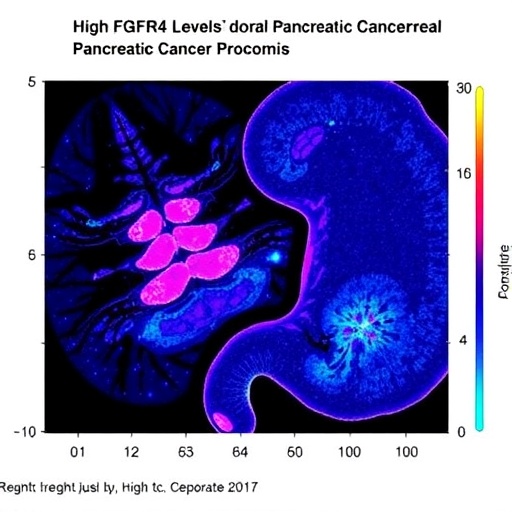In the relentless search for reliable prognostic markers in pancreatic ductal adenocarcinoma (PDAC), a new light has been shed on the role of fibroblast growth factor receptors (FGFRs). Recently published findings underscore the unique significance of FGFR4 protein expression in predicting unfavorable outcomes for PDAC patients, highlighting its potential as a critical biomarker in an otherwise challenging disease landscape.
Pancreatic ductal adenocarcinoma remains one of the most lethal cancer types, largely due to its typically late diagnosis and limited therapeutic options. Identifying molecular signatures that can forecast disease progression or recurrence could revolutionize patient management by enabling more personalized treatment strategies. While FGFRs have emerged as therapeutic targets—particularly FGFR2 gene fusions—their broader prognostic implications have been less well defined until now.
The study employed meticulous immunohistochemical analyses of FGFR1, FGFR2, and FGFR4 proteins in a cohort of 99 PDAC tumors alongside 60 samples of adjacent normal pancreatic tissue. Quantification of protein expression was done through the H-score methodology, facilitating a nuanced comparison between malignant and non-malignant tissue profiles. This approach allowed researchers to link protein expression levels with critical clinical parameters such as disease-free survival (DFS).
Results revealed a striking disparity in the expression patterns of FGFR family members. FGFR2 and FGFR4 displayed significant differential expression when comparing tumor tissue to adjacent normal pancreas, whereas FGFR1 levels remained relatively unchanged. This nuanced expression landscape pointed to a potentially distinctive role for FGFR4 within PDAC biology, warranting deeper investigation.
Most notably, high FGFR4 protein expression correlated robustly with shortened disease-free survival in PDAC patients. This association persisted across both univariable and multivariable survival analyses, suggesting that FGFR4 holds independent prognostic value beyond conventional clinical factors. In contrast, FGFR2’s high expression hinted at a trend toward poorer DFS, though it failed to achieve statistical significance, and FGFR1 showed no meaningful prognostic impact.
To strengthen these protein-level findings, researchers turned to in silico analyses utilizing publicly accessible gene expression datasets from GEO and TCGA repositories. Concordantly, elevated FGFR4 mRNA levels matched the clinical observation of diminished DFS, reinforcing the notion that FGFR4 overexpression is a robust marker of disease aggressiveness at both transcriptomic and proteomic levels.
Further computational interrogation focused on the biological pathways associated with FGFR4 overexpression. Enrichment analysis illuminated a constellation of developmental, metabolic, and stemness-related processes linked to elevated FGFR4. These pathways are often implicated in tumor progression and resistance mechanisms, suggesting that FGFR4 may actively modulate multiple dimensions of PDAC pathophysiology.
Intriguingly, these findings position FGFR4 as more than a passive molecular marker; it could represent a central regulator within oncogenic signaling networks that foster tumor recurrence and metastasis. Such a perspective opens avenues not only for prognostication but also for the design of targeted therapies aimed at FGFR4-mediated pathways in PDAC.
This research adds critical nuance to our understanding of FGFR family dynamics in pancreatic cancer. The differential prognostic relevance of FGFR family members reflects the complex and context-dependent nature of receptor signaling in malignancies. While FGFR2 has attracted attention due to gene fusions in subset populations, FGFR4’s broader impact on patient outcomes highlights the importance of comprehensive biomarker profiling.
Future clinical applications of these insights could involve integrating FGFR4 protein expression assessment into routine pathological evaluation of PDAC specimens. This integration would enable oncologists to identify high-risk patients likely to experience early recurrence, thereby refining surveillance protocols and tailoring adjuvant therapies with greater precision.
Moreover, the convergence of prognostic and mechanistic data implicating FGFR4 in metabolic and developmental pathways suggests that combination treatment strategies targeting these axes, alongside FGFR4 blockade, might improve therapeutic efficacy. Such approaches could potentially circumvent adaptive resistance mechanisms that frequently undermine single-agent therapies in PDAC.
While the study’s relatively modest sample size warrants expanded validation in larger, multicenter cohorts, the consistent alignment of protein and mRNA data alongside functional pathway analyses provides compelling evidence for FGFR4’s role as a prognostic biomarker. These findings invite renewed efforts to unravel the intricate signaling networks modulated by FGFR4 in pancreatic cancer biology.
In the broader context of oncology, this research exemplifies the critical importance of dissecting receptor family member contributions individually rather than en bloc. It highlights how subtle differences in receptor expression and function can translate into vastly different clinical trajectories, underscoring the complexity of tumor microenvironments and their molecular underpinnings.
Ultimately, the identification of FGFR4 as a predictor of poor prognosis in PDAC offers a promising new foothold in the fight against this devastating disease. By refining risk stratification and opening new therapeutic pathways, this work brings us one step closer to improving outcomes for patients facing pancreatic cancer’s formidable challenge.
Subject of Research:
Prognostic significance of FGFR1, FGFR2, and FGFR4 protein expression in pancreatic ductal adenocarcinoma.
Article Title:
High FGFR4 protein expression, but not FGFR1 or FGFR2, predicts poor prognosis in pancreatic ductal adenocarcinoma.
Article References:
Braun, M., Durślewicz, J., Sołek, J. et al. High FGFR4 protein expression, but not FGFR1 or FGFR2, predicts poor prognosis in pancreatic ductal adenocarcinoma. BMC Cancer 25, 1519 (2025). https://doi.org/10.1186/s12885-025-14976-2
Image Credits: Scienmag.com
DOI:
https://doi.org/10.1186/s12885-025-14976-2




